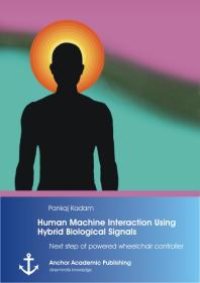
Ebook: Human Machine Interaction Using Hybrid Biological Signals: Next step of powered wheelchair controller : Next step of powered wheelchair controller
Author: Pankaj Kadam
- Tags: Artificial intelligence -- Congresses., Human-machine systems -- Design.
- Year: 2014
- Publisher: Diplomica Verlag
- City: Hamburg, GERMANY
- Edition: 1
- Language: English
- pdf
In the last decade, digital revolution has improved the living standard of people in cities and urban areas. The project is part of the effort to improve the quality of life for the elderly, quadriplegic, and individuals with muscle degeneration condition. The author has tried to merge robotic techniques with powered wheelchair systems that can assist them in their daily life and provide mobility. This project tries to merge man with the machine in a minimalistic way, and to provide safer control at the same time. In this book, the author describes the software, hardware, and the challenge faced during the implementation of the project. Auszug aus dem Text Text sample: Chapter 1.2, Types of wheelchairs: 1.2.1, Manual wheelchairs: Manual wheelchairs are propelled by the occupant by turning the hand-rims or by an attendant using handles. These are mostly used by individuals with upper-body mobility. They are of two main subtypes, rigid and foldable. Rigid chairs are preferred by active users as they have less moving parts and are light in weight. Foldable chairs are easy for storage or placement into a vehicle during travel and are mostly used at airports and hospitals. These wheelchairs can also be fitted with shock absorbers, to cushion bumps on the path [10]. The light weight wheelchairs reduce shoulder and wrist injuries due to strain, decrease the total energy expenditure and are easier for transportation. 1.2.2, Electric-powered wheelchairs: An electric-powered wheelchair uses an electric motor, a handle bar or joystick for navigation and is powered by batteries. Electric wheelchairs are used to travel a longer distance without physical exhaustion. These wheelchairs are useful for individuals who are too weak or otherwise unable to move around in a manual wheelchair. These wheelchairs are also provided to persons with cardiovascular conditions. Furthermore Electric wheelchairs can be customized to cater individual needs by adding suspension to the front and back wheels, cushioning, light weight frame, pneumatic tires for softer rolling resistance, etc. There are also sports varieties built for wheelchair athletics, playing tennis, basketball, etc [8]. 1.2.3, Limitation of the electric chairs: Steered in an upright posture, hand strength and upper-body mobility are required. Mobility scooters have longer length, which limits their turning radius in smaller lanes. It has a low ground clearance that can make it difficult to navigate around poor structured paths. They have fewer options for body support, such as head or leg rests. They are quite heavy and not portable. Need to be charged regularly. Biographische Informationen Pankaj Raghunath Kadam was born in Mumbai, India in 1988. He completed his Masters in Embedded Systems at the University of Essex, England. During his studies, he worked as an AMX programmer at the ISS (Information System Services) department at the University. He was later hired by the same department to develop, program and provide digital teaching aids at the University for 2 years. The author has received the Educational Achievement award for his Master's degree and Award of Excellence during his Bachelor studies in Engineering. Currently, the author is back in Mumbai and works as an Embedded Scientist. When he isn't glued to the computer, he spends time listening to instrumental music, plays guitar and enjoys different aspects of artwork.
Download the book Human Machine Interaction Using Hybrid Biological Signals: Next step of powered wheelchair controller : Next step of powered wheelchair controller for free or read online
Continue reading on any device:

Last viewed books
Related books
{related-news}
Comments (0)